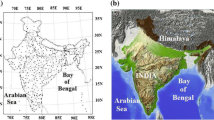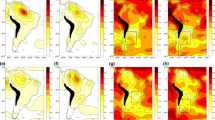Abstract
The climatology, amplitude error, phase error, and mean square skill score (MSSS) of temperature predictions from five different state-of-the-art general circulation models (GCMs) have been examined for the winter (December–January–February) seasons over North India. In this region, temperature variability affects the phenological development processes of wheat crops and the grain yield. The GCM forecasts of temperature for a whole season issued in November from various organizations are compared with observed gridded temperature data obtained from the India Meteorological Department (IMD) for the period 1982–2009. The MSSS indicates that the models have skills of varying degrees. Predictions of maximum and minimum temperature obtained from the National Centers for Environmental Prediction (NCEP) climate forecast system model (NCEP_CFSv2) are compared with station level observations from the Snow and Avalanche Study Establishment (SASE). It has been found that when the model temperatures are corrected to account the bias in the model and actual orography, the predictions are able to delineate the observed trend compared to the trend without orography correction.










Similar content being viewed by others
References
Abe M, Kitoh A, Yasunari T (2003) An evolution of the Asian summer monsoon associated with mountain uplift—simulation with the MRI atmosphere–ocean coupled GCM. J Meteorol Soc Jpn 81:909–933
Chakraborty A, Nanjundiah RS, Srinivasan J (2002) Role of Asian and African orography in Indian summer monsoon. Geophys Res Lett 29(20):2002. doi:10.1029/2002GL015522
Doblas-Reyes, Deque FJM, Piedelievre JP (2000) Multi-model spread and probabilistic seasonal forecasts in PROVOST. Q J R Meteorol Soc 126:2069–2088
Hagedorn R, Doblas-Reyes FJ, Palmer TN (2005) The rationale behind the success of multi-model ensembles in seasonal forecasting—I. Basic concept. Tellus 57:219–233
Kalra N, Chakraborty D, Sharma A, Rai HK, Jolly M, Chander S, Kumar PR, Bhadraray S, Barman D, Mittal RB, Lal M, Sehgal M (2008) Effect of increasing temperature on yield of some winter crops in northwest India. Curr Sci 94(1):82–88
Kar SC, Rana S (2014) Interannual variability of winter precipitation over northwest India and adjoining region: impact of global forcings. Theor Appl Climatol 116(3–4):609–623. doi:10.1007/s00704-013-0968-z
Kar SC, Hovsepyan A, Park CK (2006) Economic values of the APCN multi-model ensemble categorical seasonal predictions. Meteorol Appl 13(3):267–277
Kar SC, Acharya N, Mohanty UC, Kulkarni MA (2011) Skill of monthly rainfall forecasts over India using multi-model ensemble schemes. Int J Climatol 32:1271–1286
Kasahara A, Washington WM (1968) Thermal and dynamical effects of orography on the general circulation of the atmosphere. NCAR manuscript, No. 68–208
Krishnamurti TN, Kishtawal CM, Shin DW, Williford CE (2000) Multi-model superensemble forecasts for weather and seasonal climate. J Clim 13:4196–4216
Lee DE, De Witt DGA (2009) New hybrid coupled forecast system utilizing the CFSSST, 2009 forecasts [http://portal.iri.columbia.edu/portal/server.pt/gateway/PTARGS_0_4972_5734_0_0_18/NOAAabstract2009]
Mohanty UC, Ravi N, Madan OP, Paliwal RK (1997) Forecasting minimum temperature during winter and maximum temperature during summer at Delhi. Meteorol Appl 4:37–48
Murphy AH (1988) Skill scores based on the mean square error and their relationships to the correlation coefficient. Mon Weather Rev 16:2417–2424
Namias J (1980) The art and science of long-range forecasting. Eos Trans AGU 61:449–450
Pacanowski RC, Griffies SM (1998) MOM 3.0 manual. NOAA/Geophysical fluid dynamics laboratory, Princeton, 608 pp
Prasad K, Dash SK, Mohanty UC (2009) A logistic regression approach for monthly rainfall forecasts in meteorological subdivisions of India based on DEMETER retrospective forecasts. Int J Climatol 30:1577–1588
Roeckner E and Coauthors (1996) The atmospheric general circulation model ECHAM4: model description and simulation of present-day climate. Max-Planck-Institutitute fur Meteorologie Rep. 218, Hamburg, 90 pp
Saha S, Nadiga S, Thiaw C, Wang J, Wang W, Zhang Q, van den Dool HM, Pan H-L, Moorthi S, Behringer D, Stokes D, Peña M, Lord S, White G, Ebisuzaki W, Peng P, Xie P (2006) The NCEP climate forecast system. J Clim 19:3483–3517
Shepard D (1968) A two-dimensional interpolation function for irregularly spaced data. Proc. 23rd National Conf., New York, NY, Association for Computing Machinery 517–524
Shukla J, Hagedorn R, Hoskins B, Kinter J, Marotzke J, Miller M, Palmer T, Slingo J (2009) Revolution in climate prediction is both possible and necessary. A declaration at the world modelling summit for climate prediction. Bull Am Meteorol Soc. doi:10.1175/2008BAMS 2759.1
Srivastava AK, Rajeevan M, Kshirsagar SR (2009) Development of a high resolution daily gridded temperature data set (1969–2005) for the Indian region. NCC research report 8/2008. National Climate Centre, India Meteorological Department
Stefanova L, Misra V, Chan S, Griffin M, O'Brien JJ, SmithIII TJ (2012) A proxy for high-resolution regional reanalysis for the southeast United States: assessment of precipitation variability in dynamically downscaled reanalyses. Clim Dyn 38:2449–2466
Taylor KE (2001) Summarizing multiple aspects of model performance in a single diagram. J Geophys Res 106:7183–7192
Tiwari PR, Kar SC, Mohanty UC, Kumari S, Sinha P, Nair A, Dey S (2014) Skill of precipitation prediction with GCMs over north India during winter seasons. Int J Climatol 34:3440–3455
Willmott CJ (1982) Some comments on the evaluation of model performance. Bull Am Meteorol Soc 63:1309–1313
WMO (2002) Standardised verification system (SVS) for long-range forecasts (LRF). New attachment II-9 to the manual on the GDPS (WMO-No.485), volume 1, WMO, Geneva, 21pp
Yadav RK, Rupa Kumar K, Rajeevan M (2009) Increasing influence of ENSO and decreasing influence of AO/NAO in the recent decades over northwest India winter precipitation. J Geophys Res 114: D12112, doi:10.1029/2008JD011318, 1–12
Yadav RK, Yoo JH, Kucharski F, Abid MA (2010) Why is ENSO influencing Northwest India winter precipitation in recent decades? J Clim 23:1979–1993
Acknowledgments
This research has been conducted as part of the project entitled “Precipitation and temperature variability and extended range seasonal prediction during winter over Western Himalayas” at IIT, Delhi, sponsored by the Snow Avalanche Study Establishment (SASE), Chandigarh. We gratefully acknowledge the International Research Institute for Climate and Society (IRI), Data Library group for making five of their GCM-based seasonal forecasting systems available to this study. Also, the authors sincerely thank the India Meteorological Department (IMD) for providing the gridded temperature data for this study. The authors are thankful to Bianca C. for editing/correcting the English grammar of the manuscript. The authors also acknowledge the comments by the anonymous reviewers, which helped in improving the earlier version of the manuscript.
Author information
Authors and Affiliations
Corresponding author
Rights and permissions
About this article
Cite this article
Tiwari, P.R., Kar, S.C., Mohanty, U.C. et al. Seasonal prediction skill of winter temperature over North India. Theor Appl Climatol 124, 15–29 (2016). https://doi.org/10.1007/s00704-015-1397-y
Received:
Accepted:
Published:
Issue Date:
DOI: https://doi.org/10.1007/s00704-015-1397-y




